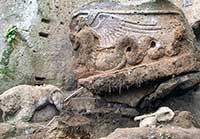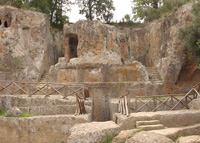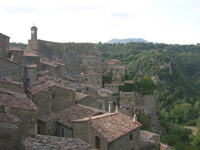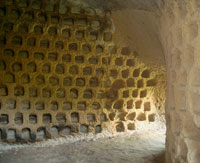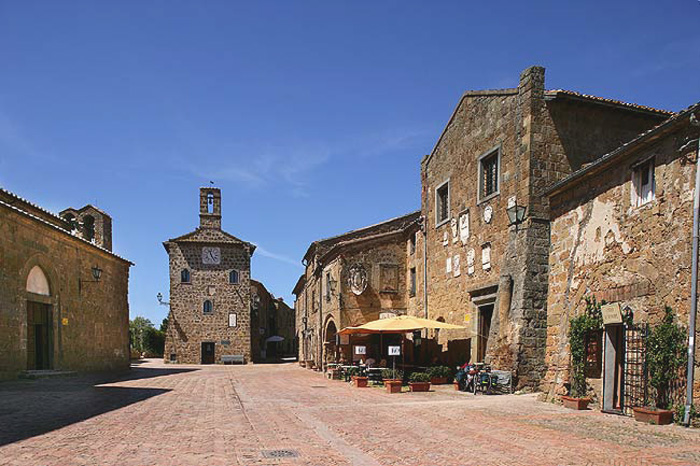 |
|
Sovana, main square with Palazzetto dell' Archivio and the Chiesa di S.Maria |
|
Sovana |
Sovana, in the southern part of ancient Etruria (Tuscany, Central Italy) represents a centre of high historical and artistic values. Its Etruscan necropolis is particularly important, even compared to other centres of ancient Etruria. |
||||
|
Sovana
|
||||
 |
 |
 |
||
| Rocca Aldobrandesca | Chiesa di Santa Maria Maggiore | Sovana, Duomo
|
||
| Sovana, the ancient capital of the Aldobrandeschi, seems to be a corner frozen in a remote age, rich with history and artistic beauty that creates an deep and unforgettable impression. Sovana was one of the principal Etruscan cities and was reborn in the Middle Ages when it became the property of the Aldobrandeschi family, who built a magnificent castle here during the 11th century. The picturesque Pretorio Piazza is one of them and is today the heart of the town. Next to this lovely piazza are the Pretorio Palazzo, decorated with an array of coats of arms, the Bourbon Palazzo del Monte, and the Church of Santa Maria, the town’s oldest building and home to the curious Archivo Palazzetto. From the Pretorio Piazza the two main streets divide heading in different directions only to be reunited once again at the feet of the magnificent Romanesque Cathedral. The oldest church of Sovana is San Mamiliano, situated on the piazza, now in ruins. You can clearly see that it was built on top of a big roman building. |
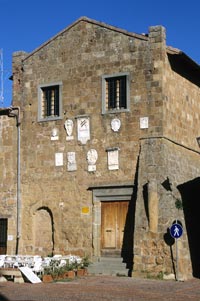 Pretorio Palazzo |
|||
The cathedral |
|
|||
 |
 |
 |
||
|
Facciata | |||
 |
 |
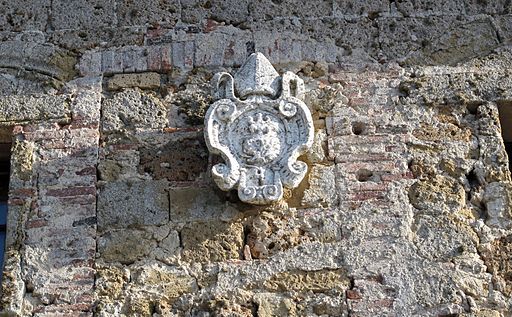 |
||
|
||||
The Aldobrandesca Fortress Rocca Aldobrandesca, probably built over a pre-existing Etruscan/Roman fortress. The current appearance dates from its 1572 renovation, when the bastions were added. Dismantled in the 17th century, today only the portal, a tower and a stretch of walls remain. |
Palazzetto dell 'Archivio
|
|||
Palazzo Comunale or Palazzo dell'Archivio is a medieval building of extraordinary beauty, built in tufaceous stone and attached to an impressive bell tower. The Palazzo dell’Archivio is situated at the mouth of a piazza, between Via del Duomo and Via di Sotto.
|
|
|||
Chiesa di Santa Maria Maggiore, a 13th century building with simple but breathtaking architectural features, houses one of the most ancient pre-Romanesque ciboria, a pre-Romanesque tabernacle, and some splendid frescoes by Andrea di Niccolò. |
|
|||
 |
 |
 |
||
Chiesa di Santa Maria Maggiore
|
||||
 |
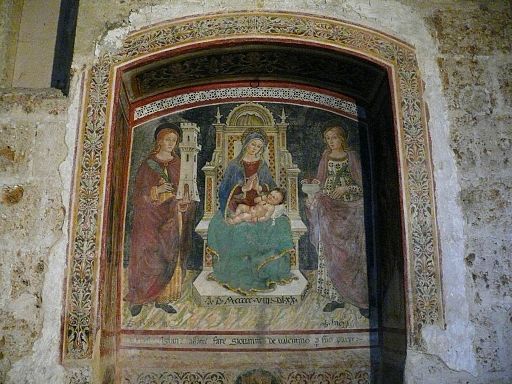 |
 |
||
|
||||
 |
 |
 |
||
|
||||
 |
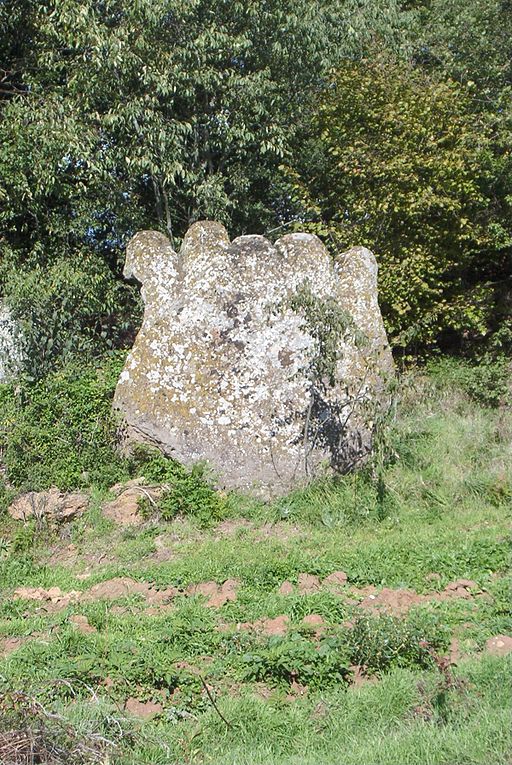 |
|||
|
||||
| The Late Renaissance Palazzo Bourbon del Monte, was built by Cosimo I de' Medici. The architecture is characterised by its rustic facade and large first floor porch. During the last years of independence, Sovana used this building as its public office. |
||||
Loggia del Capitano The Captain’s Lodge is right next to the Palazzo del Pretorio and is a portico structure held up by two arches which rest on one pillar and are embellished by the emblem of Niccolo the First, who lived here in 1570. Via del Duomo or Via di Mezzo |
||||
The Church of San Mamiliano, a medieval church built on the ruins of an Etruscan building, is maybe the most ancient of the village.
|
||||
 |
||||
Etruscan terracottas in the Museo di San Mamiliano, Etruscan statuettes
|
||||
| Archeological Sites | THE ETRUSCAN NECROPOLIS |
||||
| The Archaeological Area of Sovana is definitely one of the most interesting that the Etruscans have left us. The tombs are those of a group that lived near Suana between the VII and I centuries B.C. The oldest tombs are simple, with many loculi that lead to the hypothesis that they are the graves of shepherds who lived in small villages. The most beautiful funereal monuments date back to the beginning of the 3rd century BC, including the large Pola and the Ildebrando tomb, discovered in 1924, datingback to the second century BC and considered the most important monument of the necropolis, if not the most important Etruscan monument excavated to date. The necropolis of Sovana is located west of Sovana, along the road leading to San Martino sul Fiora. In Sovana, you can also experience a walk in the enchanting Vie Cave, imposing walkways excavated from the tufa by the Etruscans, perhaps as communication lanes, perhaps for magic rites. The tombs in Sovana were first discovered in 1843 by English archaeologist S.J Ainsley, who said, at the time, that he had never before seen so many rock-carved tombs in one place. This huge necropolis remains today one of the most important and evocative relics left behind by a civilisation that existed even before the might of the Roman Empire. The Sovanan territory is best known as the location of Via Aurelia and Via Cassia, two principal communication highways that connect to an endless series of small streets and alleys which lead all the way to the Fiora River. These ancient roads are all over Sovana but the most famous ones have to be the Vie Cave. Short in distance, these roads have become so famous simply because of the way they are carved into the volcanic rock. Once used as communication routes, the Vie Cave are covered in small caves and are close to various necropolises. Today visitors can explore these ancient roads hidden in a stunning natural paradise. The archaeological park that houses these roads covers almost the entire Tufo City territory, but it is in Sovana that you will find the most significant ancient treasures. The tombs in Sovana belong to a civilisation that lived in the area between the 7th and 1st centuries B.C. Simple and plain, the tombs are said to belong to the farmers that once lived in the small village. The more elaborate tombs were the ones built between the 3rd and 2nd centuries B.C when Suana was one of the most powerful towns in the territory. Opening of Etruscan Necropolis of Sovana weeks before Easter to 2 November 10.00-19.00 26 December - 6 January 10.00-17.00 Winter visits by prior arrangement |
|
|||
| Vitozza, now an archaeological site, was once a town made of hundreds of cave dwellings dug in the tufa stone between the Bronze Age and Middle Ages. The settlement was built during the Middle Ages as a castle and, after his abandonment of the late eighteenth century, there are the remains of two forts, a church and a distinctive rock setting, plus a group of several Colombari. In the 1200s Vitozza had a church and defence castles and people lived here, for poverty or by choice, up to the late 1700s. The green and shady path continues along the pure waters of the River Lente to Sorano, a perfectly preserved medieval town built on a cliff of tufa stone This ancient town dates back to the time of the Etruscans. Its first historical mention was in the 3rd century BC. Later, it was fought over by various duchys and today one sees the 15th century Orsini Castle in which were recently discovered a series of important renaissance frescoes. [read more] |
||||
| Ildebrando di Sovana was born in Sovana around the year 1020 and descended from the Bonizones, most likely a branch of the powerful Aldobrandesca family. Today on Via di Mezzo lies an old building, formerly headquarters of the Community of Sovana, and widely believed to be the birthplace of Ildebrando. Ildebrando di Soana left his home town to travel to Rome, where he began his ecclesiastical career at a young age. Here he also became part of the Order of the Benedictines Clunyacensi. A brilliant mind, Ildebrando enjoyed considerable popularity and wealth even before becoming Pope Gregory VII and in many ways spearheaded the Gregorian reform of this period. During his papacy, Gregorio VII heavily supported the expansion of his birth place and the entire Maremman territory. |
||||
| The Ildebranda Tomb |
||||
| The Ildebranda Tomb was discovered in 1924. Its unique architecture has earned it the title as the most important and magnificent necropolis monuments not only in Sovana but in the whole Etruscan territory. The name of the most famous Etruscan tomb of Sovana is due to the most important citizen of the maremman town, during the medieval age: the pope Gregory VII (Ildebrando da Sovana). Representing the most monumental temple tomb in the necropolis, the Ildebranda tomb is characterized by a front with columns. It was carried out in imitation of a true sacred building with a moulded high podium which was easily reached trough two lateral staircases, and a lacunar ceiling. Originally the monument consisted of six columns with high moulded bases placed on the front and three columns on both sides of the temple. All these columns were characterized by composite capitals decorated with human figure and acanthus leaves. The colonnade supported three tympana presenting a frieze in relief with a series of rosettes and snouts whose tails are held by a female figure. The upper part of the tympanum is decorated with vegetable motives. The monument was entirely covered with polychrome plaster: golden yellow, green and red? A long 'dromos' leads to the burial chamber presenting a cruciform plan and a single funerary bench. Some of the original architectural elements have been reassembled and exhibited in the Pretorio Palace of Sovana. [read more] |
||||
| Pola Tomb The Pola Tomb is located in the Felceto necropolis 300 metres from the Ildebranda tomb and close to San Martino sul Fiora. Once a grand temple, it is today marked only by a single rock-carved column that stands as a living symbol of its past splendor. |
||||
| The mermaid tomb Along with the tomb of Ildebranda, this is the most famous grave in the Sovana necropolis. It is in a beautiful setting. We reach it via a path that goes from the provincial road, crosses the Colonia river at the point where there is a charming little waterfall. We continue through a lovely forest that is ablaze with colored wildflowers in spring. The façade duplicates the facades of Etruscan homes. Above the door is a pediment decorated with high relief sculptures of a mermaid hugging two youths with her tail. This is an aedicula-type tomb, but because of the lavish decorations that depict anecdotes from the life of the deceased, it is considered a true monument. Continuing along the same path we will see various examples of semi-dado Etruscan tombs.
Via cava di San Sebastiano We continue along the path from the Mermaid Tomb. This is an old Etruscan road that linked the Tollena plateau with the Fiora valley. It gets its name from a church that stands at the opening of the valley. The path, which is entirely covered with vegetation is in a deep gorge, that is overlooked by ancient tombs in the tufaceous cliff. |
||||
| The Colombari and Tomba della Sirena Among the most interesting tombs is a great columbarium known as the Colombari Tomb. There is one tomb that stands out among the rest and that’s the Siren Tom, a round-shaped tomb where the bearded head of the Etruscan Silenus was said to have been buried. |
||||
| Upon leaving Sovana from the castle door you will find a small dirt road that leads to the Folonia Tomb. Here you will also find the Monte Rosello necropolis, whose steep ridge is home to numerous rock tombs open to visitors. |
||||
|
||
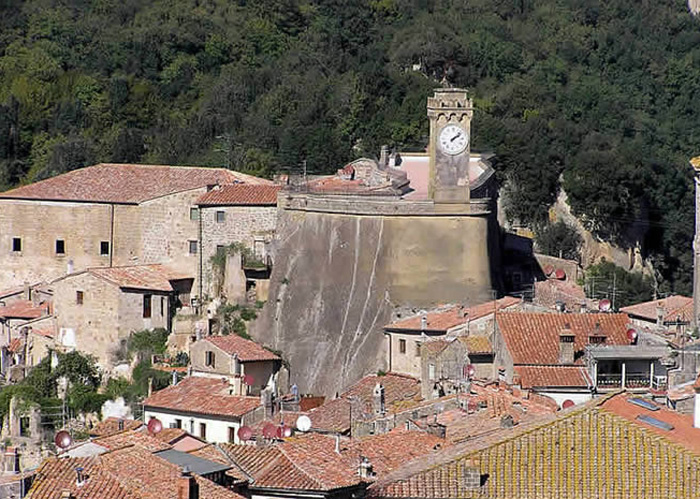 |
||
Sorano, Sasso Leopoldino |
||
| The old hamlet of Sorano rises on one of the many tufaceous spurs that flank the River Lente. Landslides caused the people to leave the village and it fell into a state of neglect, and yet the Medieval portion has remained intact. The houses are typically Medieval and tall, and inside they are quite singular. The various floors are not all on the same level: they are staggered and connected by wood or stone steps. Many of these houses were built into the natural hollows in the tufa. We can enter the village via the two gates, one in the northern section – that is not in use is known as Porta dei Merli and is decorated with the coats of arms of Cosimo II de’ Medici and Niccolò IV. On either side of the gate, there are two openings that probably held the drawbridge chains. The southern gate, also known as Porta di Sopra leads from the town hall to the village’s historic center. [Read more] Pro Loco Ufficio Informazioni Turistiche Piazza del Popolo 15 Market day in Sorano is Tuesday. |
||
|
||
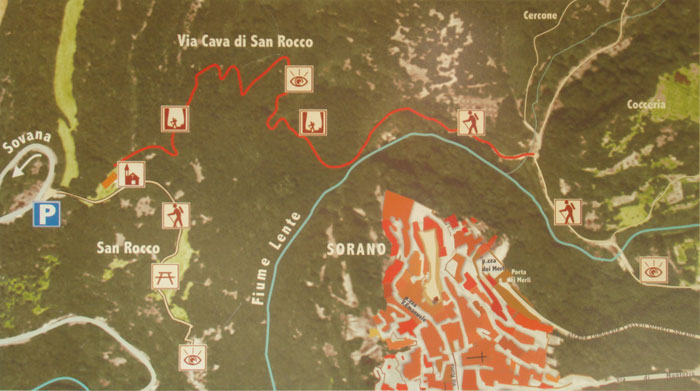
On the road from Sovana to Sorano, the Via Cava di San Rocco (and Parking) is on the left, two km before entering Sorano
|
|||
Le Vie Cave, or sunken roads, are those unusual, long, dark and narrow roads deeply set into the tufaceous rock that lead from the plateaus near Sorano and Pitigliano, down to the river banks. There are at least 15 rock-sculpted passages spreading out in every direction from the valleys between Pitigliano and Sovana. These sunken roads vie cave are enormous, up to 20m deep and 3m wide, and believed to be sacred routes linking the necropoli and other sites associated with the Etruscan religious cult. A less popular, more mundane explanation is that these strange megalithic corridors were used to move livestock or as some kind of defence, allowing people to move from village to village unseen. Two particularly good examples, half a kilometer west of Pitigliano on the road to Sovana, are Via Cava di Fratenuti, with high vertical walls and Etruscan graffiti, and Via Cava di San Giuseppe, more than 10 meters from top to bottom this pathway passes the Fontana dell'Olmo. This fountain is carved out of solid rock with the sculpted head of Bacchus, the mythological god of fruitfulness, from whose mouth water flows. Via Cava San Rocco is another fine example, near Sorano. It winds its way through the hills for 2 km between the town and the Necropoli di San Rocco. One of the largest Vie Cave roads in the area, Il Calvone is wedged between Poggio Felceto and Poggio Stanziale. Along the high walls of the road are some incredibly ancient carvings and archaic one room tombs. Among the engravings is an Etruscan unified cross or swastika, which was the symbol for the sun and the stars that radiated life. Every spring on the night of the equinox (19 March) there is a torchlit procession down the Via Cava di Giuseppe which culminates in a huge bonfire in the Piazza Garibaldi (Pitigliano), as a symbol of purification and renewal marking the end of winter. |
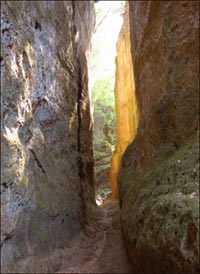 Vis Cava di San Sebastiano |
||
From Sovana to Via cava di San Sebastiano and the Siren Tomb | 2 hours |
|||
| Near to the convergence of the streams Folonia and Calesina, in the immediate vicinity of the necropolis of Sopraripa, the chapel of San Sebastiano (Saint Sebastian) is situated, from which the via cava takes its name. This path climbs up in the direction of the plain of Tollena and goes in the direction which leads to Pian Costanzo and Poggio San Pietro, then proceeds towards the valley of Fiora. The path, which is entirely covered with vegetation is in a deep gorge, that is overlooked by ancient tombs in the tufaceous cliff. In the Sopraripa Necropolis are several tombs which date back to different eras and all of which vary in size and beauty. However, there is one tomb that stands out among the rest and that’s the Siren Tomb, La Tomba della Sirena. Download pdf |
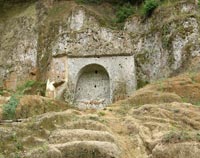 La Tomba della Sirena |
||
From Sorano to Vitozza | 3 hours |
|||
| There is a lovely excursion from Sorano to Vitozza, in the hamlet of San Quirico, one of the largest rock settlements in central Italy, with over 200 grottoes that were inhabited from prehistory until the Middle Ages. Along the path that runs along the site, you can see the remains of three fortresses, the Church of Sant'Angelo and an important Roman columbarium, all in an uncontaminated environment. From San Quirico di Sorano we pass through Vitozza. Castello di Vitozza is located about two kilometers from the town of San Quirico. The first building we see along the road leading from San Quirico to Vitozza is the Rocca or stronghold with its thick walls of even tufa stones and inscriptions with the date 1572 and the name of Niccolò IV Orsini. This section of the walls ended at a gate which controlled the access road, and its ruins are visible from either side of the path. Marked red. | 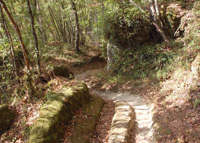 The road to Vitozza |
||
Maps: IGM, Topographic map 1:50,000 map 333 Viaggio attraverso la civiltà del tufo (Journey seen through the tufa civilisation), a guide about cultural trekking, is edited by the cooperative La Fortezza di Sovana. Inside this guide, it is possible to find pictures of the landscape, very detailed maps representing the archaeological sites situated in the whole Province of Grosseto (among which it is also feasible to find the necropolis in Sovana), and the best local trekking routes. The guide also introduces the itinerates in the hinterland of Maremma, ranging from the Municipality of Sorano and Sovana up to Pitigliano and Saturnia. The gide is for sale in the Book Shop of the Cathedral in Sovana or in the Palazzo Orsini in Pitigliano. |
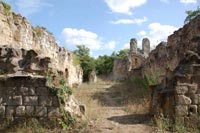 Vitozza La Chiesaccia Vitozza La Chiesaccia |
||
Sorano and the rock settlement of Vitozza | The necropolis of San Rocco |
|||
| Coming from the direction of Sovana, two kilometres from the village of Sorano, we meet the well-marked sign to the necropolis of San Rocco and its church. The Via Cava San Rocco is another fine example of a via cave. It winds its way through the hills for 2km between the town and the Necropoli di San Rocco. The necropolis is situated along the tufaceous ridge that defines the valley of the River Lente. It can be reached by following the provincial road that joins Sorano and Sovana. From Sovana go back to Pitigliano and pass the turn of to Pitigliano and proceed to Sorano. Two kilometres before you arrive to the village are the Necropoli di San Rocco, another Etruscan burial site. From here you can reach Sorano by foot following a via cava. To get there we have to cross the bridge over the river and then go up a series of hairpin curves dug into the tufa. The necropolis consists of chamber tombs carved into the rock that date from the III-II centuries B.C. Read more |
|||
 |
|||
Spectacular panoramic scenery in Podere Santa Pia... |
|||
Podere Santa Pia is a fantastic artistic property restored with minute attention to detail, situated in a hilly and unspoilt land, about one hour drive from Sovana. .
|
|||
From Pitigliano to Sovana along the vie cave |
|||
This attractive itinerary, starting from the village of Pitigliano and winding along a track through Etruscan vie cave and hilly sections, brings us to the centre of Sovana. This is a pretty route that has many interesting features, including visits to medieval villages, a gentle walk up sunny hillsides and a climb down into the area that passes through the wonderful Etruscan "vie cave". After following the road that descends through the centre of Pitigliano, we take Via Aldobrandeschi until, just before it ends, we reach Via Porta di Sovana. Read more Download pdf |
|||
From San Martino sul Fiora to Sovana |
|||
The itinerary starts in San Martino along the Via del Casone. Standing on the big new bridge over the Fiora-river between Sovana and San Martino sul Fiora, you can see remains of a roman bridge about 100 meters downstream. |
|||
Parco Archeologico Città del Tufo (it) The Cities and Cemeteries of Etruria by George Dennis, published by John Murray, in London, 1848. |
|||
Comune Sorano and Sovana Piazza del Municipio, 15 Tel. 0564-633023 | Fax 0564-633033 Ufficio Informazioni Turistiche: 0564 633099 www.comune.sorano.gr.it Opening of Etruscan Necropolis of Sovana weeks before Easter to 2 November 10.00-19.00 26 December - 6 January 10.00-17.00 Winter visits by prior arrangement Tickets: Free Maps | GM, Topographic Map 1:25,000, sheet 333 TAB III – Pitigliano Multigraphic – Tourist road map 1:50,000 - Maremma |
|||
Sovana, Castell'Ottieri, Elmo, Montebuono, Montorio, Montevitozzo, San Quirico, San Giovanni delle Contee, San Valentino are frazioni of Sorano.
|
|||
| Enlarge map | |||
|
|||


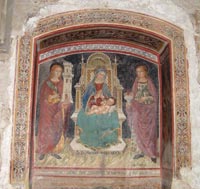

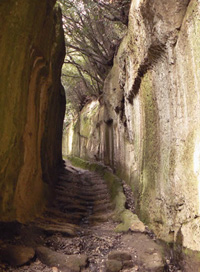 Cava di San Giuseppe
Cava di San Giuseppe